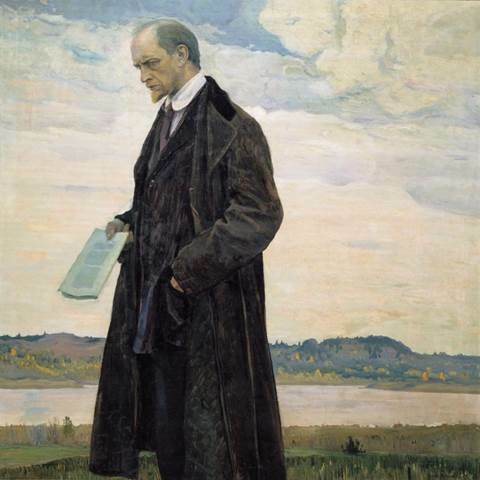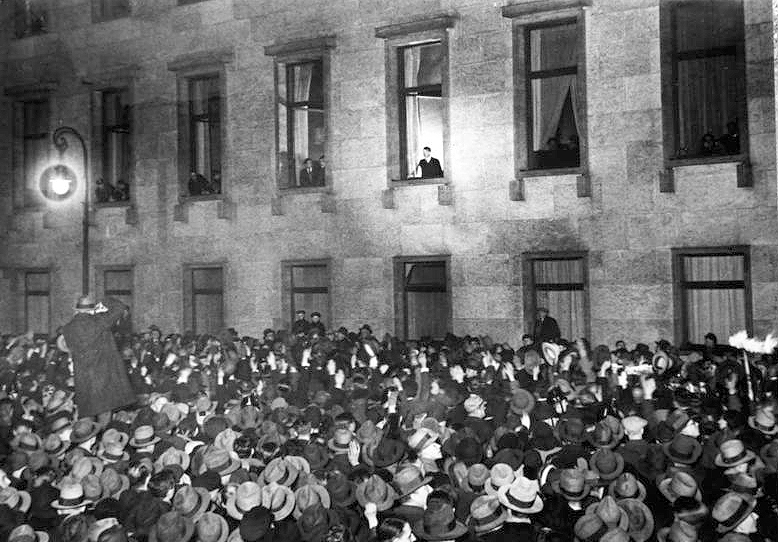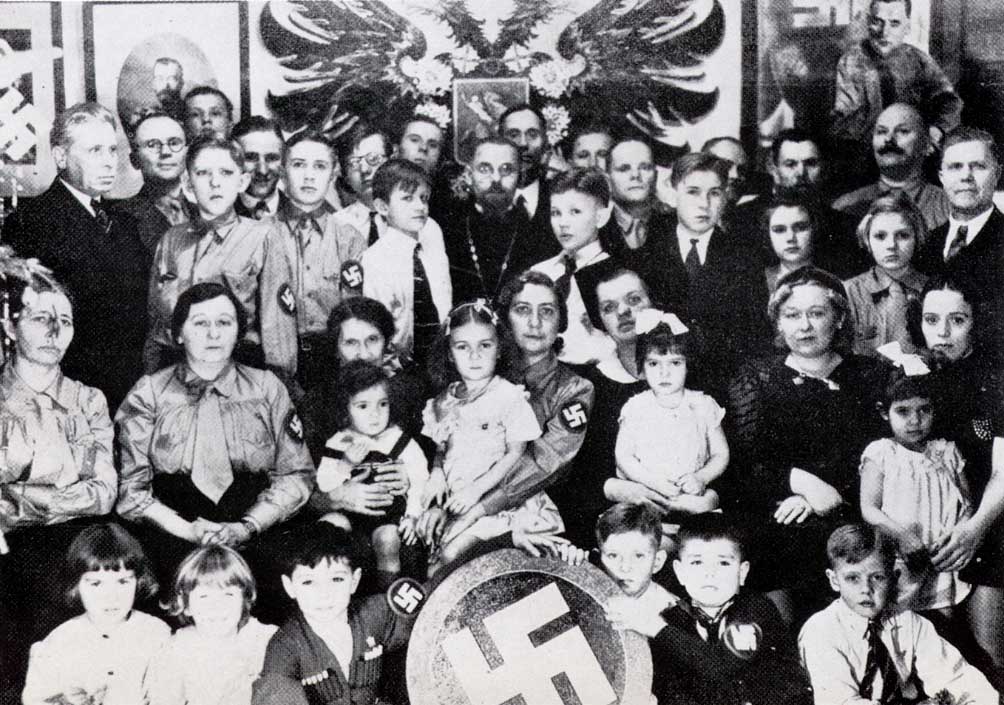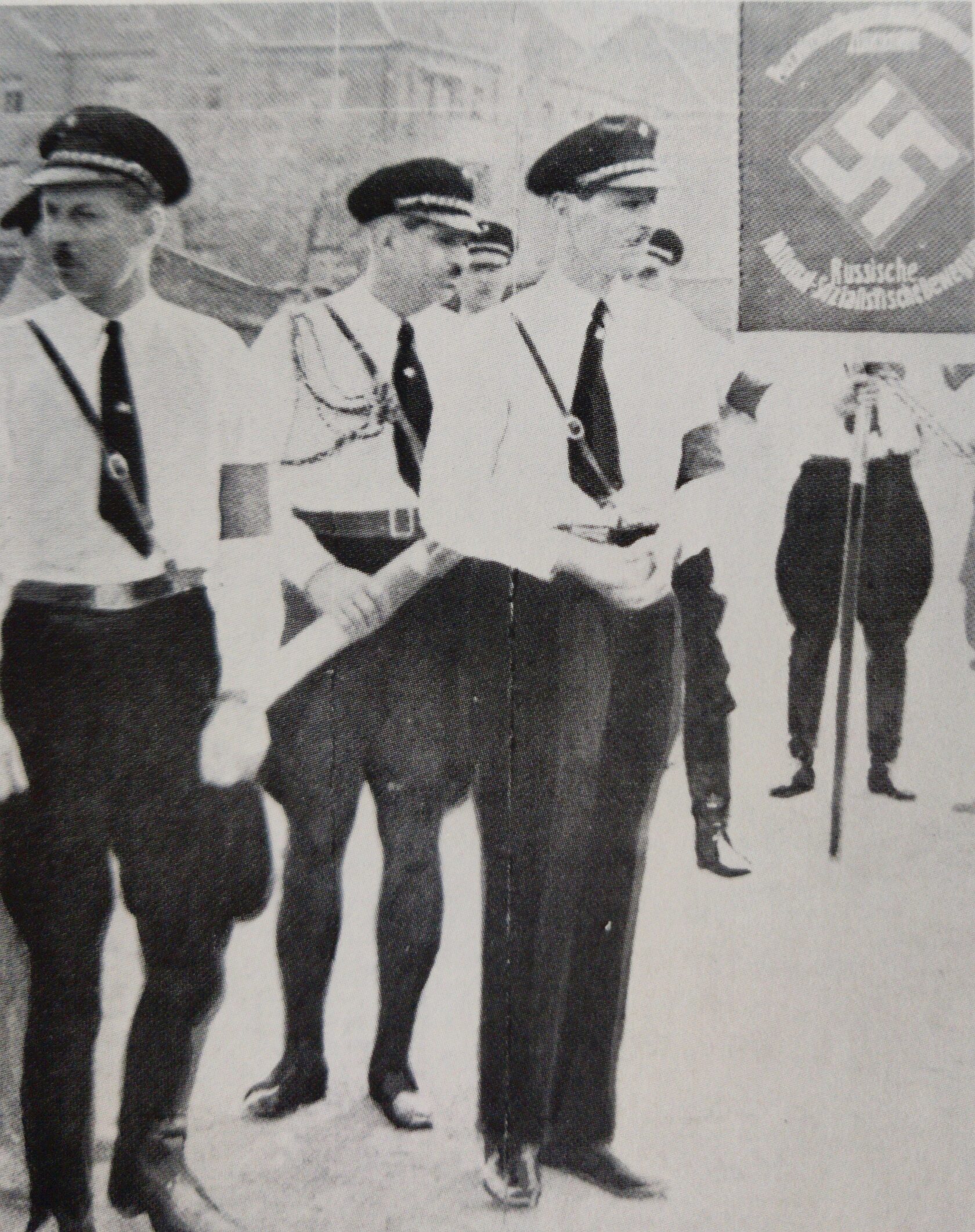The White Russians as the Operational Force
behind the Nazis’ Policy in the East
behind the Nazis’ Policy in the East
The White Russians as the Operational Force behind the Nazis’ Policy in the East
On the evening of January 30, 1933, Hitler stood at the open window of the Reich Chancellery, receiving an ovation on the occasion of his inauguration as chancellor. For many of those White Russians who had settled in Germany after the civil war, this was the sign they needed to continue their exile somewhere further west.
Indeed, Hitler regarded Slavic countries (including the Soviet Union) and their peoples as subhumans (Untermenschen) who would never be incorporated into the new German Reich he was building. Furthermore, in Mein Kampf (1925) and its unpublished sequel (Zweites Buch, 1928), Hitler had outlined the need for a new “living space” (Lebensraum) for Germany—that is, the colonization of Eastern Europe so as to acquire new sources of food for the growing Aryan(-ized) people. This concept provided the ideological background for the Master Plan East (Generalplan Ost) commissioned by Reichsführer SS Heinrich Himmler, which called for the expulsion and extermination of the “racially undesirable” population of the conquered territories, i.e., ethnic cleansing of the Slavs.
Despite all of this, some 50,000 Russians remained in Germany after 1933, 10,000 of them in Berlin.¹ Among them were four White Russian organizations. The first of these was the Russian Liberation National Movement (Rossiiskoe osvoboditelʹnoe natsionalʹnoe dvizhenie, ROND), created immediately following Hitler’s seizure of power in 1933. The ROND was led by Heinrich Petrovich Pelhau (aka Svetozarov), a Baltic German suspected of being a member of Hitler’s NSDAP (Nationalsozialistische Deutsche Arbeiterpartei). The aim of the ROND, a Nazi puppet organization, was to absorb the other White Russian organizations to make them easier for the Gestapo to monitor.
The ROND had cordial relations with a second White Russian organization, the Mladorossy, via their liaison officer, Prince Serge S. Obolenski.² The leader of the Mladorossy, Alexander Kazem-Beg, welcomed Hitler's appointment as chancellor and sent him his congratulations in February 1933.³ Immediately thereafter, he initiated a cooperation with the NSDAP-controlled ROND via its honorary president, Pavel Bermondt-Avalov, former commander of the West Russian Volunteer Army. The deal was signed on September 22, 1933, in Berlin with a third party, Anastasy Vonsiatsky, leader of the US-based All-Russian Fascist Organization (Vserossiiskaia fashiistskaia organizatsiia, VFO). The cooperation was short-lived but helps to show how promptly the opportunity to collaborate with the Nazis was seized, despite uncertainties as to the future that Hitler envisioned for Russia.
A similar lack of distrust of the Nazi regime was found in the Russian All-Military Union (Russkii obshche-voinskii soiuz, ROVS), and especially the head of its German Department, Alexei Aleksandrovich von Lampe. He simply “did not believe that Hitler would pursue efforts to put his plans for Lebensraum into action,”⁴ but if he did, von Lampe was ready to become the new Gauleiter of the Russian Reichskommissariat. Indeed, for the ROVS, the Russian civil war had never really ended; they were keen to resume the fight against the Reds, even if that meant being on the side of the Germans and having to compromise on what Russia would look like once “liberated” from the Soviets.
The fourth White Russian organization still present in Germany after 1933 was a youth organization, the People’s Labor Union (Narodno-trudovoi soiuz, NTS). Since its members had been teenagers at the time of the Russian Civil War, they had not participated in the fighting. Their old feelings of helplessness and frustration turned into blind hatred when they heard the violent tales of the veterans of the Volunteer Army, now members of the ROVS. The NTS and the ROVS were particularly close in 1933-34, and in addition to material and financial support (see section 3.2. of chapter 2), the ROVS provided the NTS with ideological assistance.
The architect thereof was ROVS ideologue Ivan Alexandrovich Ilyin (1883-1954), who instilled in NTS members the concept of “irreconcilability” (neprimirimost’). In his 1925 book On Resistance to Evil by Force (O soprotivlenii zlu siloiu), Ilyin argued that struggling against evil was necessary for the good of one's soul. If one ceased to resist evil, then in self-justification one would begin to convince oneself that perhaps the evil was not so bad after all. The less one resisted evil, the more one was prone to having one’s character undermined thereby.⁵ Among the members of the NTS, who had never set foot on a real battlefield, this idea translated into a very activist, even reckless, attitude. Indeed, in Ilyin’s doctrine, the NTS found moral and religious justification not only for collaboration, but for letting the Nazis destroy their homeland so that they could rebuild it anew.
Indeed, Hitler regarded Slavic countries (including the Soviet Union) and their peoples as subhumans (Untermenschen) who would never be incorporated into the new German Reich he was building. Furthermore, in Mein Kampf (1925) and its unpublished sequel (Zweites Buch, 1928), Hitler had outlined the need for a new “living space” (Lebensraum) for Germany—that is, the colonization of Eastern Europe so as to acquire new sources of food for the growing Aryan(-ized) people. This concept provided the ideological background for the Master Plan East (Generalplan Ost) commissioned by Reichsführer SS Heinrich Himmler, which called for the expulsion and extermination of the “racially undesirable” population of the conquered territories, i.e., ethnic cleansing of the Slavs.
Despite all of this, some 50,000 Russians remained in Germany after 1933, 10,000 of them in Berlin.¹ Among them were four White Russian organizations. The first of these was the Russian Liberation National Movement (Rossiiskoe osvoboditelʹnoe natsionalʹnoe dvizhenie, ROND), created immediately following Hitler’s seizure of power in 1933. The ROND was led by Heinrich Petrovich Pelhau (aka Svetozarov), a Baltic German suspected of being a member of Hitler’s NSDAP (Nationalsozialistische Deutsche Arbeiterpartei). The aim of the ROND, a Nazi puppet organization, was to absorb the other White Russian organizations to make them easier for the Gestapo to monitor.
The ROND had cordial relations with a second White Russian organization, the Mladorossy, via their liaison officer, Prince Serge S. Obolenski.² The leader of the Mladorossy, Alexander Kazem-Beg, welcomed Hitler's appointment as chancellor and sent him his congratulations in February 1933.³ Immediately thereafter, he initiated a cooperation with the NSDAP-controlled ROND via its honorary president, Pavel Bermondt-Avalov, former commander of the West Russian Volunteer Army. The deal was signed on September 22, 1933, in Berlin with a third party, Anastasy Vonsiatsky, leader of the US-based All-Russian Fascist Organization (Vserossiiskaia fashiistskaia organizatsiia, VFO). The cooperation was short-lived but helps to show how promptly the opportunity to collaborate with the Nazis was seized, despite uncertainties as to the future that Hitler envisioned for Russia.
A similar lack of distrust of the Nazi regime was found in the Russian All-Military Union (Russkii obshche-voinskii soiuz, ROVS), and especially the head of its German Department, Alexei Aleksandrovich von Lampe. He simply “did not believe that Hitler would pursue efforts to put his plans for Lebensraum into action,”⁴ but if he did, von Lampe was ready to become the new Gauleiter of the Russian Reichskommissariat. Indeed, for the ROVS, the Russian civil war had never really ended; they were keen to resume the fight against the Reds, even if that meant being on the side of the Germans and having to compromise on what Russia would look like once “liberated” from the Soviets.
The fourth White Russian organization still present in Germany after 1933 was a youth organization, the People’s Labor Union (Narodno-trudovoi soiuz, NTS). Since its members had been teenagers at the time of the Russian Civil War, they had not participated in the fighting. Their old feelings of helplessness and frustration turned into blind hatred when they heard the violent tales of the veterans of the Volunteer Army, now members of the ROVS. The NTS and the ROVS were particularly close in 1933-34, and in addition to material and financial support (see section 3.2. of chapter 2), the ROVS provided the NTS with ideological assistance.
The architect thereof was ROVS ideologue Ivan Alexandrovich Ilyin (1883-1954), who instilled in NTS members the concept of “irreconcilability” (neprimirimost’). In his 1925 book On Resistance to Evil by Force (O soprotivlenii zlu siloiu), Ilyin argued that struggling against evil was necessary for the good of one's soul. If one ceased to resist evil, then in self-justification one would begin to convince oneself that perhaps the evil was not so bad after all. The less one resisted evil, the more one was prone to having one’s character undermined thereby.⁵ Among the members of the NTS, who had never set foot on a real battlefield, this idea translated into a very activist, even reckless, attitude. Indeed, in Ilyin’s doctrine, the NTS found moral and religious justification not only for collaboration, but for letting the Nazis destroy their homeland so that they could rebuild it anew.

Ilyin in 1921, by Mikhail Nesterov
Source
Source
Chapter Content
Introduction
Adolf Hitler standing at an open window of the chancellery, the night of his appointment as Chancellor of Germany on January 30, 1933
Source
Source

Teachers and students of the Russian Fascist Bible School (VFO) in New York (30s)
Source
Source

Explore the networks, citations, and documents using the buttons on the right

ROND troops celebrating May Day in Berlin in 1933 (Fashist)
From: John J. Stephan, The Russian fascists, Harper & Row, 1978
From: John J. Stephan, The Russian fascists, Harper & Row, 1978
Content Oriented Web
Make great presentations, longreads, and landing pages, as well as photo stories, blogs, lookbooks, and all other kinds of content oriented projects.

Content Oriented Web
Make great presentations, longreads, and landing pages, as well as photo stories, blogs, lookbooks, and all other kinds of content oriented projects.
Tilda Publishing
Appendix 1
NKVD document on Oleg Klimov
Appendix 2
Poland’s support for Georgian independence and anti-Soviet activities
Interwar Poland and the Intermarium Idea
Appendix 3
Appendix 4
Tilda Publishing
Georgian Collaborationism
Appendix 4
Tilda Publishing
Excerpts of Ruchenko memoirs
Appendix 5
Vineta Operation
Tilda Publishing
A report from the Kiev NKVD surveillance on Herman Strekker
Appendix 6


Content Oriented Web
Make great presentations, longreads, and landing pages, as well as photo stories, blogs, lookbooks, and all other kinds of content oriented projects.
[1] John Glad, Russia Abroad: Writers, History, Politics (Tenafly, NJ: Hermitage Publishers; Washington, DC: Birchbark Press, 1999), 305.
[2] Mireille Massip, La vérité est la fille du temps. Alexandre Kasem-Beg et l’émigration russe en Occident (Geneva: George Editeur, 1999), 226.
[3] Ibid., 224.
[4] Oleg Beyda, “‘Iron Cross of Wrangel’s Army’: White Russian Émigrés and the German-Soviet War, 1941–1945” (PhD diss., Univeristy of New South Wales Canberra, 2019), 35.
[5] Paul Robinson, “The White Russian Army in Exile, 1920-1941” (PhD diss., University of Oxford, 1999), 189.
[2] Mireille Massip, La vérité est la fille du temps. Alexandre Kasem-Beg et l’émigration russe en Occident (Geneva: George Editeur, 1999), 226.
[3] Ibid., 224.
[4] Oleg Beyda, “‘Iron Cross of Wrangel’s Army’: White Russian Émigrés and the German-Soviet War, 1941–1945” (PhD diss., Univeristy of New South Wales Canberra, 2019), 35.
[5] Paul Robinson, “The White Russian Army in Exile, 1920-1941” (PhD diss., University of Oxford, 1999), 189.
